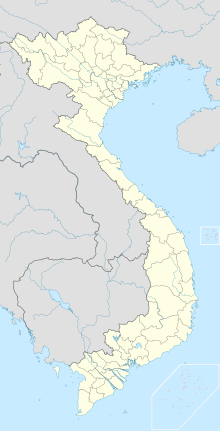Hang Sơn Đoòng
| Hang Sơn Đoòng | |
|---|---|
| Sơn Đoòng cave | |
 View from inside the mouth of the cave | |
| Location | Quảng Bình Province, Vietnam |
| Depth | Max 150m / 490ft |
| Length | Approx 9,000 m / 30,000 ft |
| Discovery | 1991 [AD] by Hồ-Khanh |
| Geology | Limestone |
| Entrances | Approx 2 |
| Hazards | Underground river |
| Cave survey | 2009, British/Vietnamese |
Hang Sơn Đoòng ('cave of the mountain river'[1] or 'mountain cave of Đoòng [village]' in Vietnamese),[disputed – discuss] also known as Sơn Đoòng cave (often without the tone marks) is a solutional cave in Phong Nha-Kẻ Bàng National Park, Bố Trạch District, Quảng Bình Province, Vietnam. As of 2009[update] it has the largest known cave passage cross-section in the world,[2][3] and is located near the Laos–Vietnam border. Inside is a large, fast-flowing subterranean river. It was formed in Carboniferous/Permian limestone.[4]
Discovery
Hang Sơn Đoòng was found by a local man named Hồ Khanh in 1991. The whistling sound of wind and roar of a rushing stream in the cave heard through the entrance as well as the steep descent prevented the local people from entering the cave. Only in 2009 did the cave become internationally known after a group of scientists from the British Cave Research Association, conducted a survey in Phong Nha-Kẻ Bàng from 10 to 14 April 2009.[1] Their progress was stopped by a large, 60-metre (200 ft) high calcite wall,[1] which was named the Great Wall of Vietnam. It was traversed in 2010 when the group reached the end of the cave passage.
Description
According to the Limberts, the cave is five times larger than nearby caves like Phong Nha Cave and Hang En, the third largest cave in the world previously considered the biggest cave in Vietnam. The main passage in Sơn Đoòng is more than 5 kilometres (3.1 mi) long, 200 metres (660 ft) high and 150 metres (490 ft) wide. With these dimensions, Sơn Đoòng overtook Deer Cave in Malaysia in 2009 to take the title of the world's largest cave.[5][6] The cave runs for approximately 9 kilometres (5.6 mi) and is punctuated by 2 large dolines, which are areas where the ceiling of the cave has collapsed. The dolines allow sunlight to enter sections of the cave and has resulted in the growth of trees as well as other vegetation.[7]
The cave contains some of the tallest known stalagmites in the world, which are up to 70 m tall. Behind the Great Wall of Vietnam were found cave pearls the size of baseballs, an abnormally large size.[8]
-
Son Doong cave doline
-
Another view out the mouth of the cavern, showing the rainforest in its doline.
-
Reflecting pool further inside
-
Cavers' campsite much deeper inside
Tourist activities
In early August 2013, the first tourist group explored the cave on a guided tour at a cost of US$3,000 each.[9][10] Permits are required to access the cave and are made available on a limited basis. Only 500 permits were issued for the 2015 season, which runs from February to August.[11] After August, heavy rains cause river levels to rise and make the cave largely inaccessible.
See also
References
- ^ a b c Dykes, Brett Michael (January 3, 2011). "Explorers discover spectacular caves in Vietnam". Yahoo!. Archived from the original on 2011-01-06.
- ^ "World's Biggest Cave Found in Vietnam". National Geographic. July 9, 2009.
- ^ Guinness World Records 2013, Page 032. ISBN 9781904994879
- ^ "Gerological Map of Vietnam, Kampuchea, and Laos". Retrieved 15 May 2014.
- ^ "World's largest grotto unveiled in Vietnam".
- ^ "Britons claim to find world's largest cave". The Daily Telegraph. London. 30 April 2009.
- ^ Son Doong Cave. "Son Doong cave, Hang Son Doong - Map".
- ^ "In Vietnam, World's Largest Cave Passage - Pictures, More From National Geographic magazine".
- ^ "Five miles long, and with its own rivers and jungle: The world's largest cave is open for tours... you just have to trek for a day and a half and then abseil down a Vietnamese cliff to get there". Daily Mail. London.
- ^ "First foreign tourist group explores Son Doong Cave". Saigon-gpdaily. 2013-08-07. Retrieved 2013-08-08.
- ^ "Son Doong Cave Reservations". 2015-07-13. Retrieved 2015-07-13.
External links
- "Vietnam's Mammoth Cavern". Retrieved 2010-12-21. National Geographic pictorial of Hang Sơn Đoòng
- "American Film Crew's Backstage Inside Son Doong". Retrieved 2015-05-18. Saigon-online-SonDoong-cave
- Strutner, Suzy (September 7, 2013). "World's Largest Cave, Son Doong, Prepping For First Public Tours" (includes video). The Huffington Post. Retrieved September 11, 2013.
- Chùm ảnh khám phá hang động đẹp và lớn nhất thế giới(includes images) Quảng Bình Province Template:Vi
- "In pictures: Inside Hang Son Doong, the world's largest caves in Vietnam". Retrieved 2014-06-20. The Telegraph Online
- "Hang Son Doong" (video on Vimeo). Retrieved March 17, 2015.
- "National Geographic Video March 19, 2015".





